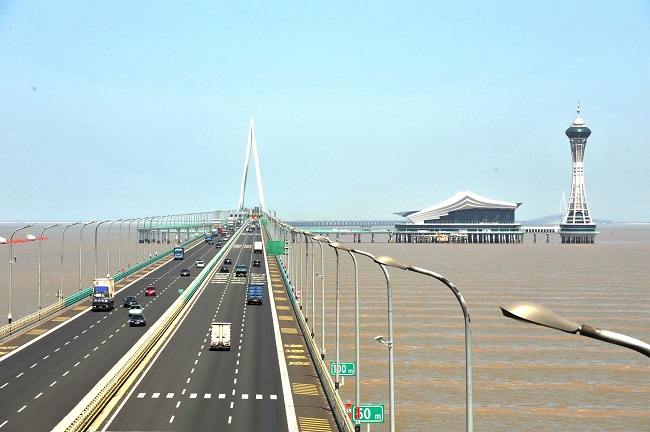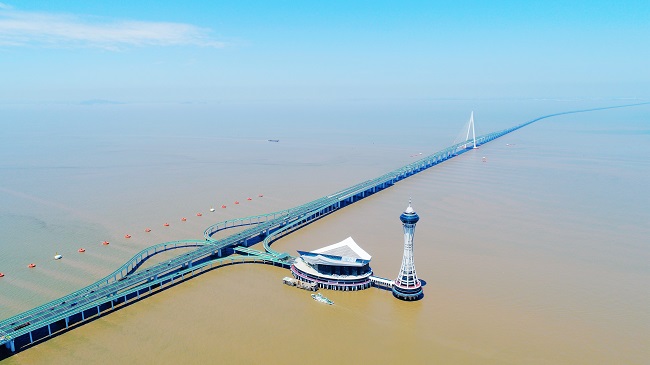Hangzhou Bay Bridge: a milestone in the history of China's cross-sea bridge construction

The Hangzhou Bay Bridge
On May 1, 2008, China's self-financed, self-managed, self-designed and self-constructed Hangzhou Bay Bridge, then the world's longest cross-sea bridge, was formally completed and opened to traffic.
Hangzhou Bay Bridge is a major landmark project in the same tradition as the Three Gorges Project and the Qinghai-Xizang Railway. The bridge featured in the torch relay for the 2008 Beijing Summer Olympics, with the relay route spanning from the main section to Nanhangdao Bridge, a distance of 18 kilometers.
The Hangzhou Bay Bridge is a convenient passage across the Hangzhou Bay along the coastal corridor of the "Five Vertical and Seven Horizontal" national trunk road network, which is an integral part of the Tongjiang-Sanya Coastal Expressway. It features a two-way six-lane highway with a design speed of 100 kilometers per hour and a design service life of 100 years. The bridge spans from Haiyan in Jiaxing to Cixi in Ningbo and is about 36 kilometers long, making it the longest cross-sea bridge built or under construction at the time in the world. The total investment in the Hangzhou Bay Bridge was approximately 11.8 billion yuan ($1.6 billion), which was the largest investment in a bridge project in China at the time. Seventeen private enterprises held a 28.64 percent stake in the project, marking a pioneering entry of large-scale private capital into national mega infrastructure projects in China.

The Hangzhou Bay Bridge
Construction of the bridge began on November 14, 2003 and, during a four and-a-half year period, builders made over 250 technological innovations, which included the development of nine major series of independent core technologies. The project set multiple world records, reaching an overall international advanced level. It has become an important milestone in the history of China's cross-sea bridge construction, opening a new chapter in the world's bridge engineering history.
Prior to the construction of the Hangzhou Bay Bridge, the CCCC Second Harbor Engineering Company invested over 400 million yuan ($55 million) to build the world's most advanced multifunctional pile driver, including the "Haili 801," and three domestically advanced concrete mixing ships. The company successfully secured contracts worth nearly 1.4 billion yuan ($192 million) for four sections, with a total construction axis length of 16.3 kilometers, meaning it undertook the most sections and also faced the greatest engineering challenges in the construction of the Hangzhou Bay Bridge. This historic leap witnessed the transformation of the company from the "River Era" to the "Ocean Era" in bridge construction.
During construction, workers used their spirit of independent innovation, leading bridge construction technology, advanced large-scale core equipment, and modern advanced management model to achieve 10 "firsts" along the entire line of the Hangzhou Bay Bridge. They overcame numerous technical challenges, set multiple "records", acted as the "pathfinders" of Hangzhou Bay, and made remarkable contributions to the bridge by enabling its full opening 8 months ahead of schedule. Their efforts also contributed significantly to the improvement of construction technology for the Hangzhou Bay Bridge and even for cross-sea bridge projects in China as a whole. The Hangzhou Bay Bridge project department of the CCCC Second Harbor Engineering Company was awarded with the "National May 1st Labor Award." Li Weizhou, deputy manager of the project department, received the "National May 1st Labor Medal" and Qin Tida, executive deputy manager of the project department, won the title of "National Excellent Project Manager." Additionally, the project department was honored with the title of "Zhejiang Province Meritorious Competition Advanced Collective" by the People's Government of Zhejiang Province.
The opening of the Hangzhou Bay Bridge has ushered the Yangtze River Delta region into a new era of regional connectivity. It has significantly reduced the travel distance between cities in the Yangtze River Delta, transforming the road network layout of the Hangzhou Bay region from a "U" shape to an "A" shape. The land transportation distance between Shanghai and Ningbo has been shortened by 120 kilometers, creating a two-hour "Golden Triangle" transportation circle between Shanghai, Hangzhou and Ningbo.
The distance from Shanghai to both Wenzhou and Taizhou in Zhejiang has been shortened as well, allowing for direct travel across the Hangzhou Bay. The distances between southeast Zhejiang and south Jiangsu have been reduced, shortening the distances among Suzhou, Wuxi, Changzhou, Ningbo and Shaoxing to just over 200 kilometers. These developments are of significant strategic importance for enhancing Shanghai's role as a central city, strengthening economic integration, and bolstering international competitiveness of the Yangtze River Delta region.









